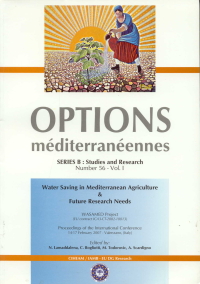| Article précédent | p. 143-151 | Article suivant |
Improving water use efficiency of field crops through regulated deficit irrigation
Deficit irrigation occurrence while maintaining acceptable yield represents a useful trait for crop production wherever irrigation water is limited. A seven year experiment (1998-2004) was conducted at Tal Amara Research Station in the Bekaa Valley of Lebanon to determine water use, yield and water use efficiency in four annual crops; maize (1998-1999); soybean (2000-2001); cotton (2001-2002) and sunflower (2002-2003). At harvest, 1m2 quadrates were sampled randomly from the different irrigation treatments to determine yield and its components. Water use efficiency at grain (WUEg) and seed (WUEs) bases was calculated as the ratio of dry yield to crop evapotranspiration (Y/ET), while water use efficiency at biomass-basis (WUEb) was calculated as the ratio of dry biomass to ET (B/ET). Water use efficiency of cotton (WUEl) was calculated as the ratio of lint yield at dry basis to evapotranspiration. Finally, results showed that deficit irrigation at mature seeds in soybean was more profitable compared to full bloom and seed enlargement. Moreover, flowering was the most critical stage of sunflower to deficit irrigation and therefore deficit irrigation at this stage should be avoided, while it can be acceptable at seed formation. For cotton, timing irrigation deficit at first open boll has been found to provide the highest lint yield with maximum WUE, in comparison to deficit irrigation at early boll loading and mid boll loading. For maize, deficit irrigated-treatment produced less seed yield but resulted in higher water use efficiency that the well irrigated control.
- [ Afficher ]
- [ Télécharger ]
- [ Exporter la citation ]
Vous pouvez télécharger la citation au format :
- [ Imprimer ]
-
Mots-clés
BIOMASSE, DOSE D'IRRIGATION, EFFICACITE, EVAPOTRANSPIRATION, GOSSYPIUM, HELIANTHUS ANNUUS, LIBAN, LYSIMETRE, METHODE D'IRRIGATION, RENDEMENT DES CULTURES, SOJA, UTILISATION DE L'EAU, ZEA MAISCiter cet article
Karaa K., Karam F., Tarabey N. Improving water use efficiency of field crops through regulated deficit irrigation. In : Lamaddalena N. (ed.), Bogliotti C. (ed.), Todorovic M. (ed.), Scardigno A. (ed.). Water saving in Mediterranean agriculture and future research needs [Vol. 1]. Bari : CIHEAM, 2007. p. 143-151. (Options Méditerranéennes : Série B. Etudes et Recherches; n. 56 Vol.I). Proceedings of the International Conference WASAMED Project (EU contract ICA3-CT-2002-10013), 2007/02/14-17, Valenzano (Italy). http://om.ciheam.org/om/pdf/b56_1/00800108.pdf



